The last time I posted was to write about my terrible experience backpacking while pregnant. Now that I’m well into the 2nd trimester and the chronic puking has slowed down (and hopefully will stop soon), I’m ready to start backpacking again. I’ve got tickets for Egypt booked and plan on camping out in the White Desert.
But that leaves me with a new problem: How the hell am I going to carry a heavy backpack while pregnant?
Is It Safe to Wear a Backpack During Pregnancy?
Most doctors will say that it is completely okay to wear a backpack (or babywear) throughout pregnancy. Obviously though, you will want to listen to your body. If you feel pain even without a backpack on, then you probably don’t want to load up your spine any more than it already is with the baby weight.
I did come across some who claim that wearing a backpack is a terrible thing to do during pregnancy. This midwife claims that the extra weight of a backpack can stress nerves, interfere with the baby’s development, interfere with blood flow, and impact the position of the baby.
Seems to be a bit of an exaggeration though!
One mama in the Babycenter community did make a good point about muscle recovery though.
“My muscle recovery from hiking was terrible during my last pregnancy. Where I would have been sore for a day normally … I was sore for at least 3! It must just take the body longer to metabolize and repair everything.”
So while it may still be safe to wear a backpack during pregnancy, it doesn’t necessarily mean it will be comfortable. Pregnancy is the time to go lightweight as possible with your backpack! Also read: Ultralight Backpacking Tips for Reducing Weight from Your Pack
What Backpacks Do to Your Posture
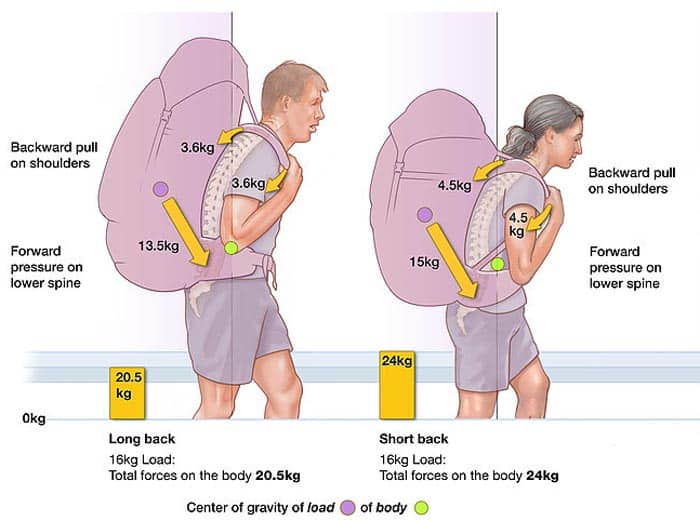
Before we get into how to wear a backpack during pregnancy, we’ve first got to talk about what backpacks do to your posture.
A backpack pulls back on your body. To compensate for the weight, your shoulders and neck rotate forward. The forward posture tilts your pelvis. This curved spinal posture is known as kyphosis. (1)
Here’s what happens to your muscles:
- Pectorals shorten
- Hip flexors shorten
- Glutes (butt) lengthen
- Mid and lower traps (back muscles) lengthen
This all equals back and hip pain. (2)
Wearing a hip belt helps shift the backpack weight away from the shoulders and neck and onto your pelvis. When you are in your 2nd and 3rd trimester though, you aren’t going to be able to wear a hip belt comfortable. So, you are stuck with the weight on your shoulders and will likely end up in a kyphosis position.
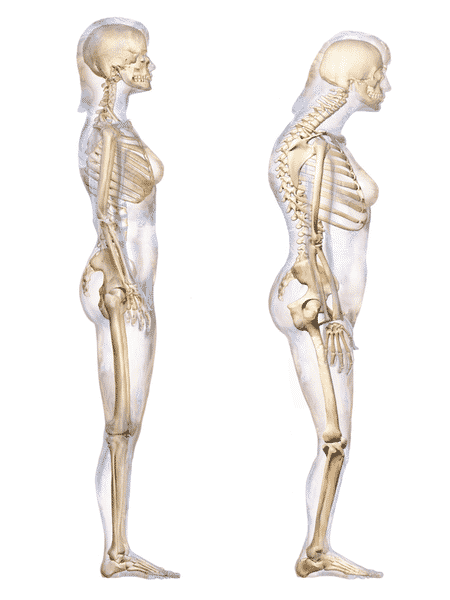
Notice the upper spinal curve of kyphosis.
What Pregnancy Does to Your Posture
At the risk of sounding like one of those “women were put on the earth to bear children” assholes, our bodies were built to carry a baby for 9 long months.
Women actually have different spinal structures than men. Three of our lower vertebrae are interlocked (as opposed to just two in men) so they are stronger. They are also spaced further apart so they can flex backwards more. This is so our spines can better adjust to the weight of a heavy baby without being damaged. (3)
That doesn’t mean the weight of carrying a baby doesn’t take its toll.
As the baby and our breasts get larger, our centers of gravity shift towards the front. To compensate, some women lean backwards. This puts a lot of stress on the hips, knees and ankles. It also makes the woman’s spine curve so her butt sticks out in what is known as lordosis. (4, 5, 6)
Pretty much all women will get some degree of lordosis during pregnancy (our spines are designed to do this). But some women also start to lean forward. The result is that they end up with both lordosis and kyphosis. Basically, they’ve got S-shaped spines. (7)
Add to this the fact that the hormone relaxin loosens muscles and ligaments during pregnancy to prepare for birth. Your muscles have to work hard as hell to keep your spine stable. No wonder women experience so much lower back pain during pregnancy! (8)
The image below from Braceability shows how a woman’s posture suffers during pregnancy. You can also find a really good image of lordosis/kyphosis throughout pregnancy here.
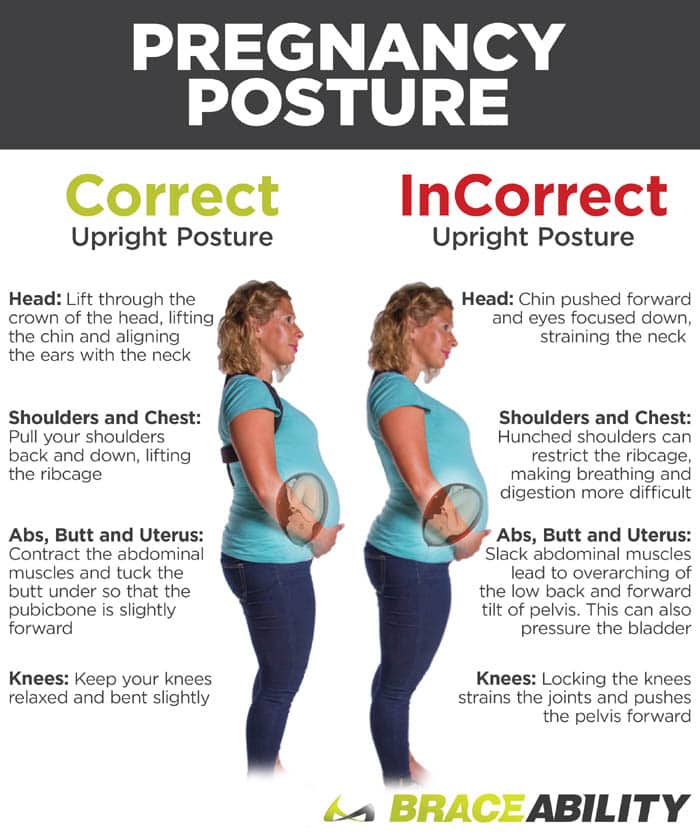
The Combined Effect on Posture?
Wearing a backpack gives you kyphosis (curved upper spine). Pregnancy gives you lordosis (curved lower spine) and kyphosis.
The combined effect can be disastrous to your posture and cause you a lot of pain!
Again, that doesn’t necessarily mean it is dangerous for you to wear a backpack during pregnancy. You just need to make some adjustments.
Pregnancy Backpack Solutions
The obvious solution would be to have someone carry most of your gear for you during pregnancy so you don’t need to wear a heavy backpack. That answer doesn’t help (especially when you’ve already got tickets booked for your next trip). So, here are some solutions to make wearing a backpack during pregnancy easier.
Pack Your Backpack Differently during Pregnancy
Typically, backpacks should be packed so the heaviest items are in the middle and top. This assumes that you will be able to wear a hip belt and transfer the weight to your pelvis. Since you can’t do this during pregnancy, you’ve got to make some adjustments.
I started looking closely at the Aarn Tate method of backpack carrying. The basic idea is that you divide the backpack load between a back pack and a front pack. This counterbalance methods prevents your shoulders from tilting forward (kyphosis) to compensate.
When looking at pictures of the Aarn Tate method, you’ll realize that the front pack is a lot like a baby bump. So, just act as though your baby bump is the front pack and pack your backpack with the method.
The image below compares the traditional packing method with the Aarn Tate method of packing. Since you won’t be wearing a front pack (aka Bodypack), substitute “medium” for “heavy” and so forth.
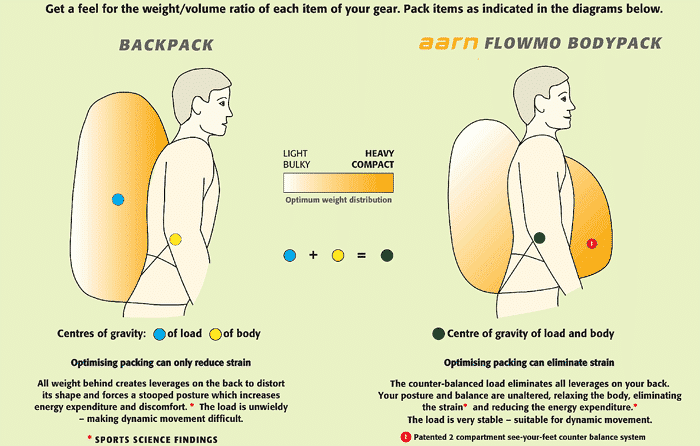
With this method you:
- Put heavy items near the bottom instead of the top. This helps shift the center of gravity so you don’t lean forward.
- Light items goes near the top.
- Use a slim backpack
- Choose a shorter backpack instead of one that goes to your head
It isn’t just Aarn Tate which touts this packing method. The US military commissioned a study which found that low center of gravy backpacks improved trunk stability. In translation? Putting heavy items near the bottom helps when your core muscles are practically non-existent from baby bump!
Use a Shorter Backpack
Standard backpacking packs (especially ones designed for men) go way up to your head. This is fine when you’ve got a hip belt to help transfer the weight to your pelvis.
However, when you are pregnant and already have an off-kilter center of gravity and no hip strap, a tall pack is just going to strain the heck out of your shoulders. Using a shorter pack will reduce shoulder strain so you don’t lean forward to compensate.
Use BackTPack to Distribute Weight to the Sides
I personally haven’t tried these packs but they seem to be very good at reducing spinal loads. The idea is that you balance the load between two packs. The packs are strapped together in a way which keeps them from moving around too much. They even advertise the backpacks specifically for pregnant women.
Your shoulders will still probably end up pulling upwards to compensate for the load. However, this is a lot better than pulling forward and getting yourself in a kyphosis posture.
I don’t think these would be good for backpacking. However, they seem awesome for everyday use and easily fit a laptop.
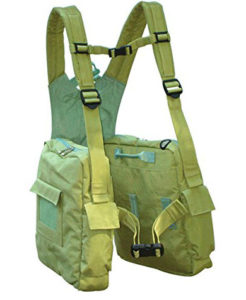
Add an Extra Sternum Strap to Use above the Belly
You won’t be able to use your backpack hip belt during pregnancy, which means your pack can wobble around a lot.
One easy solution is to add a thick sternum strap – but place it so it goes above your belly (as opposed to below). Just don’t tighten it too much or it might feel like it is restricting your breathing!
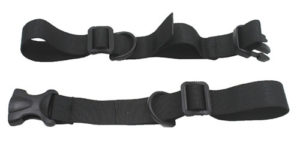
Exercise!
Most importantly, do your best to stay active during pregnancy. There are a lot of exercises you can do during pregnancy to strengthen your back muscles and even your core too.
I recommend getting a good trainer (after checking with your doc, of course). Even though I already know which exercises to do, having the trainer to check my posture has been indispensable.
Some good exercises and stretches for pregnant backpackers are:
- Standing pelvic tilts
- Arch and rounds
- Quadriped arm/leg rises
- Side planks
- Pigeon pose stretch
- Squats
- Lunges
- Skater squats
- Wall psoas hold
- Calf raises
- Rowing
Be sure to avoid any exercise that uses your ab muscles so you don’t end up with diastasis recti, a condition when your abs separate too far.
Use Trekking Poles
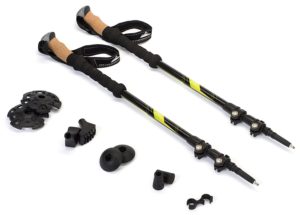
And while we are at it, hiking poles should be considered mandatory when backpacking pregnant. They’ll help add stability and take strain off of your spine. Here’s what you need to know about hiking poles.
Image credits:
Kyphosis_Degenerative by BruceBlaus, Creative Commons Attribution-Share Alike 4.0 International
“39 weeks pregnant and hiking” (CC BY-NC-SA 2.0) by Eric Willis


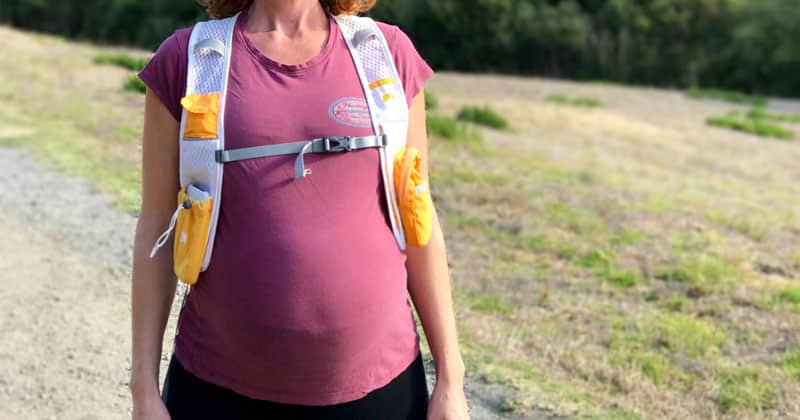


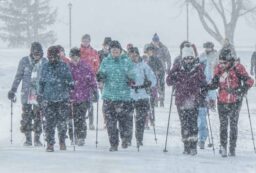







6 Comments
Rhetta Cypert
November 21, 2019 at 4:56 pmHoly smokes. Thank you so much for this. I am planning on having a baby next year but (and this sounds so petty) I was really bummed about missing a whole season of hiking and backpacking. There is SO little information out there about backpacking while pregnant, thanks so much for this overview of how to stay safe and enjoy my favorite outdoor pursuit!
Diane
November 22, 2019 at 1:15 amI’m glad this helped you. But I’m also slightly giggling that you are thinking about this so far ahead because there’s so much you can’t plan or anticipate about pregnancy and babies (like how crappy I felt about not following Leave No Trace as I puked all over the trail while pregnant on a backpacking trip – had to cut that trip short!).
It’s not petty at all to enjoy the activities you love. On the contrary, it sets a good example to your kids. I’m sure you’ll find ways to get outdoors and do all the stuff you love– while pregnant and once the little one arrives. 🙂
Sheena
January 20, 2020 at 10:39 pmHi Diane, I’m glad I came across this article. 🙂
I’m also expecting and love the outdoors. I’m currently at 11 weeks and got asked if I’m down to go backpacking in Feb for a 2 night trip. (I would be around 15 weeks by then). I guess my main concern is the food. I’m all about my Mountain House freeze dried food when I go backpacking but this time it will be different. Any suggestions on the kind of food I can/should pack and the stuff I should avoid?
My other concern would be telling off the loving people around me telling me I should hold on on backpacking for now. LOL!
Diane
January 22, 2020 at 12:08 pmI dehydrate my backpacking meals, which gives me a lot more flexibility in terms of food choices, less sodium and added crap, and is a lot lighter. I’ve got a book of recipes here: /gourmet-as-heck/ That might be something to keep in mind for a later trip, assuming you don’t want to try dehydrating now.
Mountain House has decent ingredients but crap tons of sodium. Wild Zora and Go-To Go are much better in terms of sodium and have good amounts of protein (see a comparison chart here: /best-backpacking-meals/)
You can also make your own freeze dried meals from bulk ingredients — that will eliminate the sodium but requires a bit more work/planning. Here’s how: /diy-freeze-dried-backpacking-mealss/
Since it’s only two nights, then weight isn’t such an issue — bring lots of extra snack foods which you actually like and don’t upset your stomach (I had hypermesis, so was puking until my throat bled. Hopefully that’s not an issue with you!). Maybe some protein powder (one which doesn’t taste like crap) to mix into oatmeal? Or at least buy some good high-protein energy bars.
I’d definitely bring along some electrolyte packs. You’ll get dehydrated a lot faster on the trail pregnant than non. Even if you don’t think you need them, drink some mid-day.
As for the annoyingly-concerned people telling you to stay off the trail, politely remind them physical activity while pregnant increases blood flow to the baby and reduces the likelihood of pregnancy complications like blood clots. 😀
Rosalyn
April 27, 2022 at 10:25 amThanks so much for this article, it was really interesting. I have a slightly different question that I haven’t been able to find an answer to on the internet and that is, do you have any advice about wearing a 16 kg toddler in a backpack whilst hiking pregnant? It’s harder to move the load up and down as he needs to sit where he fits, if that makes sense. I need to wear the hip belt quite tight to take pressure off my shoulders etc. Am wondering if you have any thoughts on the pressure across my lower abdomen in regards to the pregnancy?
Thank you.
Diane
April 28, 2022 at 12:20 pm16kg is really heavy. I’m not pregnant anymore and can barely carry my 16kg daughter. I’m not a doctor but wearing a tight hip belt certainly doesn’t seem like a good idea.
Have you considered getting an off-road stroller? They are expensive but it would make going on hikes with little a LOT easier. Once you have your baby, you could wear the baby and the older child could go into the stroller once he/she got too tired to walk further. Obviously you won’t be able to go on a lot of small trails even with an off-road stroller, so it really limits where you can go. I sometimes would bring a bike lock with me on hikes and, when the trail got too rough for the stroller, would lock the stroller to a tree and continue on foot. The downside is that we always had to hike out the same way we came in, but at least we were able to do some longer hikes without me getting exhuasted from carrying my heavy kid.